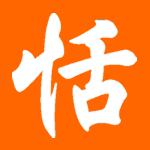Reader Matthias emails:
"Hi Tian, attached you will find a picture of a hand bag that I saw in Germany. If I'm not totally wrong, the kanji means 'bad', which is the perfect kanji next to a heart symbol. :-)"
I wonder which outfit would match well with this hand bag, perhaps an "I hate myself and I want to die" sweat shirt?
惡 = evil, wicked, bad, foul


Note that it's the Japanese version of the character. It's another good example of partial simplification by the Japanese.
ReplyDelete惡 (traditional)
悪 (Japanese)
恶 (simplified)
i'm puzzled by the use of the word "partial" to describe the different forms of chinese characters found in japanese, as if one starts at the traditional characters of hk and taiwan and inevitably ends up at the simplified characters of the mainland. it's not that sort of spectrum.
ReplyDeletethere are characters even more complicated than the standard traditional, and there are characters even simpler than the standard chinese simplified characters that just aren't in modern use. yet, i don't kno of anyone who refers to either form of written chinese as "partially simplified." i don't understand why japanese kanji is seen as somehow between the two forms of commonly written chinese.
it's not as if, during the reform process in the 1940s, the japanese looked at some characters that they had borrowed from china and said, "well, let's simplify it, but not as much as the communist chinese are going to do, about a decade or so in the future."
the japanese simplified forms are their own forms. some of them happen to coincide with the chinese simplified forms, and some of them don't. i think it would be better to just consider them "different," rather than "partial," because of the implications that brings with it.
Good way to use the letter. Funny.
ReplyDeleteRegarding simplification, I agree with Andy. Simplification
doesn't have to be gradual although I reckon the
original poster used the word "partial" just to point out
the simple fact that the Japanese forms are between two
forms.
That was me. "Partial simplification" is a term I made up. All I mean is that "partially simplified" characters are simpler than traditional characters, but more complex than the official simplified set. Your point is well taken; I'll have to find some other term.
ReplyDelete> the official simplified set
ReplyDeleteYou dropped the ball there.
What's this "official" supposed to mean?
Are you saying the Japanese simplification is not official?
"official" stand for china mainland simplified. In europe they call it official chinese because it is the Hanzi version of China. So it is called official chinese.
ReplyDeleteJust like french of France is official french. If Quebec was to simplify french (which could be fine) it would not be french no more. It would be Quebecois. Get it Ken?
Japanese simplification is not official hanzi, but it is official kanji.
I do make a strict difference between hanzi and kanji.
So :
-Chinese (hanzi)
-Chinese simplified (hanzi)
-Japanese simplified (kanji)
-Chinese and Japanese warped (a.k.a. kanzi or hanji) ^,^
Although I think there is a need for a OFFICIAL chinese hanzi...
All these simplifed® traditional© traditional©hongkong™ traditional©singapour™ traditional©taïwan™ is not going to help anyone.
When will they decide to have chinese plain and simple? ^__^